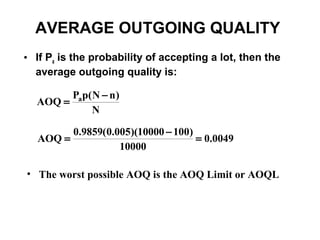The document discusses two main types of statistical sampling for quality control: acceptance sampling and statistical process control. Acceptance sampling involves inspecting finished products to determine whether to accept or reject the entire lot, while statistical process control involves sampling processes to determine if they are operating within acceptable limits. The document then provides more details on acceptance sampling, including its purposes and advantages, how acceptance sampling plans are designed, typical applications of acceptance sampling, and how operating characteristic curves are used to calculate acceptance sampling plans.





















































